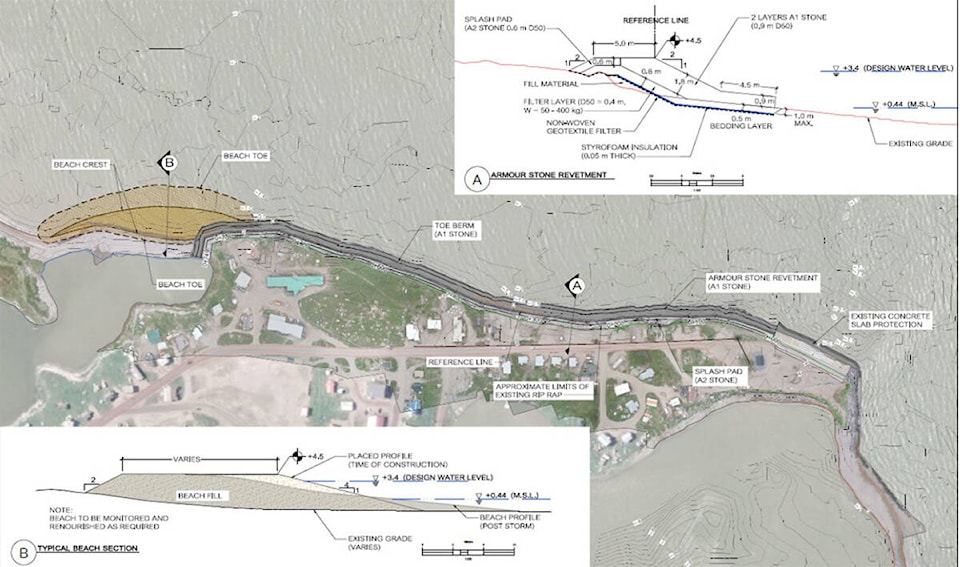Protecting the coast of Tuktoyaktuk from the onslaught of climate change is estimated to cost at least $42 million and is only guaranteed to last until 2052.
That’s the latest update on the ongoing efforts to mitigate erosion along the Arctic coast, which was presented to residents of Tuktoyaktuk Sept. 13 at Kitti Hall.
“We can’t just leave it, it’ll wash away. There are people’s lives at risk at the North end of the community,” said Mayor Erwin Elias. “The idea is to buy us time so we can plan for the next stage moving forward.
“Climate change is real in our community. It’s been six to seven years that we’ve been putting a lot of work into this and pushing it, and it’s come a long way.”

Developed by Baird Engineering, a global coastline and waterway-focused firm, the plan calls for a multi-layered approach, which has been tested at the National Research Council laboratories in Ottawa from Dec. 2020 to March 2021. Baird listed three possible options for a protective layer over the coastline, however one plan clearly stood out as less costly, easier to maintain and having less impact on the surrounding ecology.
Using a “rock revetment” system, the engineers plan to put down layers of Styrofoam insulation and geotextile to protect the permafrost from rising temperatures on the surface. This will require a metre of excavation to reach the permafrost and bedrock. After the insulation is buried, the coastline will be covered in large boulders, which will serve as an “armour stone.”
These armour stones will be placed inwards from the edge of the coast extending over 10 metres on land. Beneath the larger boulders will be layers of smaller “filter stones”, which will sit on top of a layer of even smaller rocks. The usage of different sizes of rock is to allow for filtration of water as it washes up the shoreline, explained the report. Smaller boulder armour stones will form up the backdrop of the seawall. The design anticipates an increase of 3.4 metres in sea level.
Between the hamlet and Tuk Island, it’s estimate the project will require over 30,000 cubic metres (m3) of large boulders, just over 30,000 m3 of smaller stones, nearly 40,000 m3 of Styrofoam insulation, over 40,000 m3 of geotextile filter and just over 10,000 m3 of filler.
Because the boulders are more flexible than the concrete slabs currently being used to protect the shoreline, the freeze-thaw cycle is expected to displace the seawall far less. The design selected also minimizes the amount of ocean floor that will need to be disturbed to build the seawall. It also doesn’t require the seawall to be built as high and costs substantially less than the other two options, estimated at $34,606,000 for both the hamlet and Tuk Island. For comparison, the other two plans are estimated to cost $70,628,000 and $65,425,000.
The Hamlet of Tuk is also expected to provide a $3,860,000 contingency fund in case more rock and sand is needed than anticipated. Cost impacts of the Covid-19 pandemic have not been factored into the budget at this time. Elias explained the study has only identified 60 per cent of the costs, so the final cost of the project was likely going to the higher than the current $42 million price tag.
“We need to get to another 40 per cent completion to determine the real cost,” he said. “Also taking into consideration the effect of inflation.
“Once we’re there, we get to the proposal stage and the tendering process.”

The rock revetment plan also includes refilling the southern beach along the hamlet with over 33,000 m3 of sand. The report notes the sand will need to be topped up periodically, estimating 30,000 m3 more sand will be placed over the lifetime of the project.
Their next step is to determine if the needed rock can be sourced from Inuvik quarries. Evaluation of the quality of rock is underway and the report cautions costs could escalate if the rock needs to be mined from further south. The report notes the engineers’ preference is to source the rock from Inuvialuit Regional Corporation-owned quarries along the Inuvik-Tuktoyaktuk Highway, employing local people to do the majority of the work.
Work will be completed over the wintertime to take advantage of the thick ice, pending funding. If all goes according to plan, a contract should be awarded by midway through 2022 and work should get underway next winter. The project is scheduled to be finished by the end of 2024.
Tuktoyaktuk Island is eroding away at an average of two metres per year. At the current rate, the entire island will be gone by 2050 unless mitigation is put in place. The island shelters both the hamlet and harbour from ocean waves. The harbour itself has significant cultural and historical importance to the community.
Coastlines around the hamlet are eroding away at an average of one metre per year. So far, that has forced the relocation of several houses to avoid collapsing into the Arctic Ocean and the community graveyard is now at risk of crumbling into the sea. Previous efforts to reduce the speed of erosion have included installing concrete slabs on the coast, placing geotubes along the coastline and lining it with armour stones, none of which have managed to keep nature at bay.
